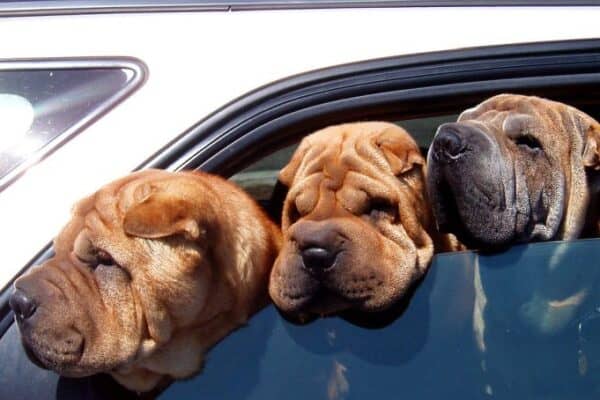
Does Your Dog Get Car Sick?
Car travel is one of the great joys of life for many dogs, while for others it is a small nightmare because they get nervous and queasy in the car. Sometimes dogs get nervous precisely because they get nauseated, which can even lead to vomiting in the car, further cementing the pooch’s negative association with car travel. My book The Dog Bible actually has a pretty good section on how to slowly get your dog used to the car — which is the same as how to get her over her dislike of the car with some practical basics. Although there are more details in the book, there are some basic concepts.
Desensitize and Counter Condition
A dog’s negative reaction to getting in the car can become a vicious cycle quite quickly — a cycle which needs to be interrupted as soon as possible with behavior modification: desensitization and counter-conditioning. “Desensitization” involves putting the dog in the car and having only good things happen when she is in there. For example, you start the dog’s car experience with the car parked in the garage or driveway — without driving at all! You can read or work on your mobile device while you dog chills in the back. Every so often you can cause something wonderful to happen in the back of the car (a form of “counter-conditioning”) by tossing her a treat. (I’m a big fan of the Halo freeze-dried Liv-a-Littles because they are a super yummy high value treat — and being all protein and small, don’t contribute to chubbiness!) You can also put a chew toy (cow ear, rawhide, dental chew, a safe bone) back there so she can distract herself. Or you can brush her in the car if she likes that. You can do this for 10 minutes or stay there much longer. You do it for several days in a row. Once she will lie down and relax without driving anywhere, then you can drive the car around the block — tossing those treats when you get to a corner! — and then park again and stay in the car with your pooch. Eventually you increase the distance you drive and keep that positive counter-conditioning going (toss treats over your shoulder). Also once you have increased to a longer overall distance, make frequent stops and let her out on a leash to stretch her legs, pee, and generally get her “legs under her.”
Should You Use Medications for Travel Sickness?
Recently on this episode of DOG TALK Dr. Nick Dodman discussed the use and misuse of tranquilizers for dogs, particularly when traveling.
While it is possible to turn to medications for nausea, car sickness is often a combination of a physical reaction to the car’s motion (and seeing things whizzing by out the window!), a memory of having felt bad or thrown up previously, and the anxiety this produces. Dr. Nick says that a medication like the anti-nausea pill Cerenia addresses the problem if it is solely nausea. It is a drug used as an anti-emetic for those dogs getting cancer treatments (who are the rare ones who experience nausea from chemotherapy) and dogs with severe intestinal upsets to stop their vomiting. However, when a dog’s reaction to being in the car is not just heaving or vomiting, but includes signs of anxiety like panting, salivating, pacing, and whining, we know these all to be typically anxious behaviors that cannot be addressed by an anti-emetic drug.
On the other hand, there is a drug called Busperone that is both an anti-nausea and anti-anxiety drug, which would make it seem perfect. But Dr. Dodman explains in the interview that the published dose of the drug is far too low, in his opinion, to get good results. However, since most vets do not know this and only dispense it at the low levels generally recommended, it doesn’t solve the problem so you still need to rely on behavior modification to slowly turn car time into a happy time for your pooch.
—Tracie Hotchner
(Have a comment? Share it on Facebook.)
Halo is a sponsor on Radio Pet Lady Network, by our invitation.
photo credit: emdot anti botox brigade via photopin (license)

